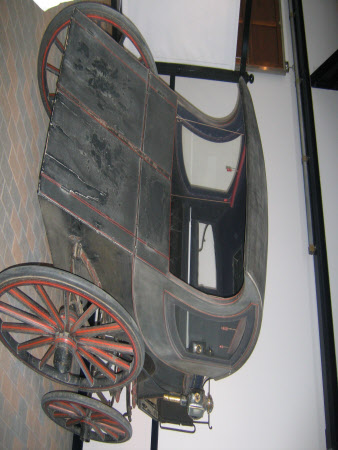Punch carriage
Hayman and Co, Exeter
Category
Carriages & other vehicles
Date
1870
Materials
Painted wood body with wool cloth upholstery and four rubber shod wheels.
Measurements
209 x 263.5 x 165cm (6ft 10 1/4in x 8ft 7 3/4in x 5 ft 5in)
Place of origin
Exeter
Order this imageCollection
National Trust Carriage Museum
NT 272874.1
Caption
This unusual carriage is said to have been designed for a country doctor. Easy access was provided from wide opening doors, with room for the doctor to write up his notes while protected from the elements. It is evident that the design was not popular, because carriages of this type are not seen in old photographs, and this is believed to be the only example to have been made.
Summary
Punch Carriage built by Hayman and Co. of Exeter circa 1870. Punch Carriage (four wheels) for a single horse. This carriage has an enclosed box, trimmed in black leather. The body is on full elliptic springs and has a pair of shafts and two candle lamps. The interior has four cushions and is of dark blue wool cloth with red blinds. Painted in a black livery with red lining.
Full description
This unusual carriage type is said to have been designed by a coachbuilder named Clark, of Aberdeen, for a country doctor. The derivation of the name is not known, but it has been suggested that the profile of the back of the carriage is like the silhouette of Mr. Punch. This example was built by Hayman & Co., the well-known Exeter coachbuilder, in the late 1800s. The design provided easy access to the body, with room for the doctor to write up his notes while protected from the elements. It was also useful should the doctor want to transport a patient in reasonable comfort. It can carry two passengers and was driven by a coachman with a groom beside him, and pulled by one horse. It is evident that the design was not popular, because carriages of this type are not seen in old photographs, and this is believed to be the only example to have survived. This carriage is on loan from the Science Museum, London.
Marks and inscriptions
On nearside front axle cap. : HAYMAN & CO. EXETER On offside front axle cap.: HAYMAN & CO. EXETER On nearside rear axle cap.: HAYMAN & CO. EXETER On offside rear axle cap.: HAYMAN & CO. EXETER On front offside axle components: 215 WARRENTED LONDON On front nearside axle components.: 215 WARRENTED LONDON On rear nearside axle components.: 215 WARRENTED LONDON On rear offside axle components.: 215 WARRENTED LONDON
Makers and roles
Hayman and Co, Exeter, coach builder


